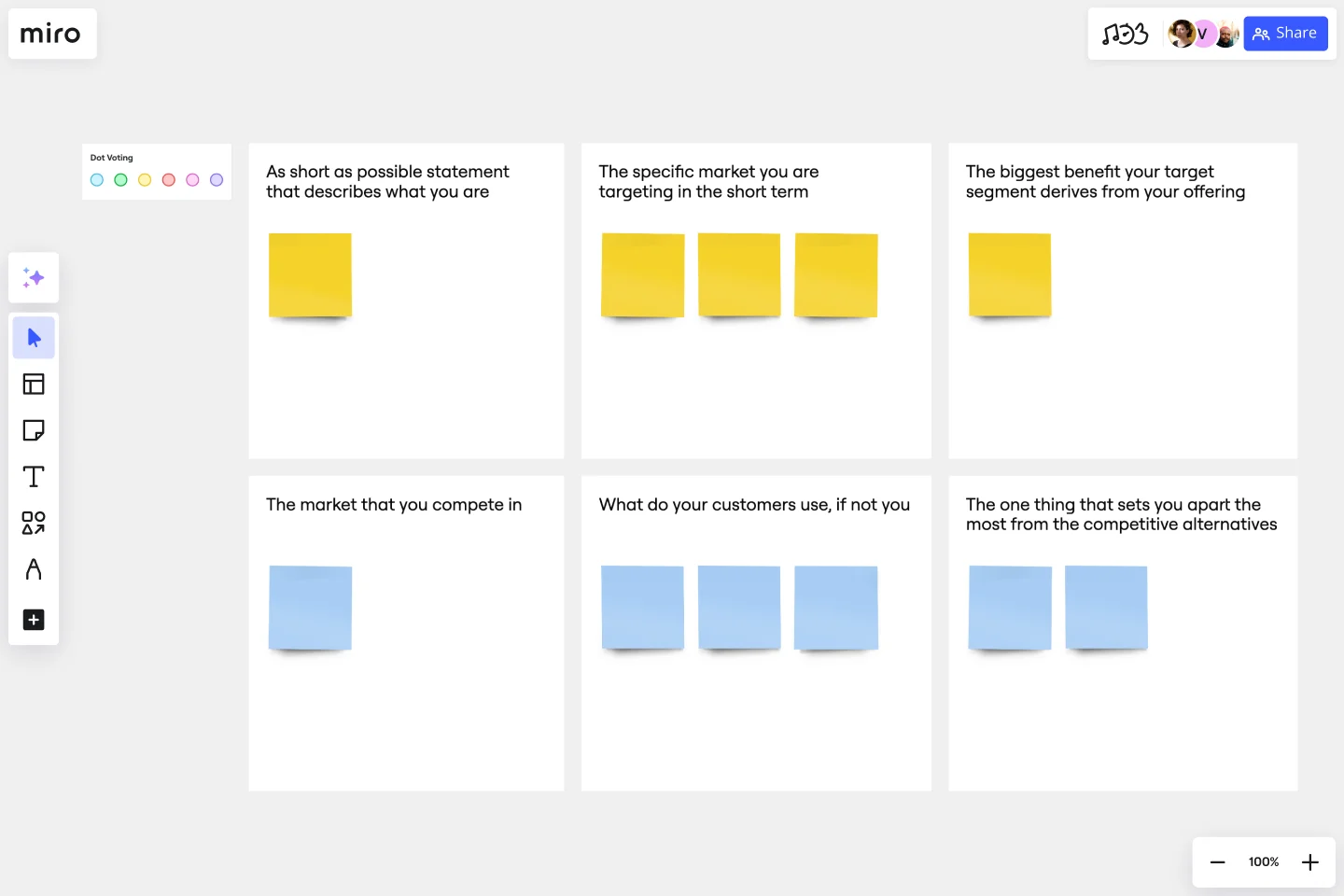Product Positioning Template
Create your strategy for launching a new product or entering a new market with the product positioning template.
About the Product Positioning Template
The success of your company largely depends on the market you are operating in. So, it is necessary to conduct a product positioning exercise before you start building products and planning strategies. This exercise is intended to determine where your company and its offering stands in the market. Although the format of these exercises may differ, it is generally advised to have these objectives in mind:
Define your customer: Who would buy your product or service?
Define the problem: What pain point are you solving for your customer? How does this problem impact your customers? It can also be useful to think about your customers’ experience of this problem. What emotions might they feel when they encounter the problem? This will help you market and design your product offering.
Define key market characteristics: What else do your customers usually buy? How do they buy it? What makes them switch products?
List the other companies in your market: Are these companies your potential partners? Potential competitors? What is their business model? How have they been successful? How have they failed? What is their biggest pain point?
Design an elevator pitch: Your pitch should encompass your customers, their pain points, and how your product is uniquely positioned to solve their problem.
Narrow down your competitors: Now that you have your pitch list your competitors and their strengths and weaknesses relative to your offering.
How to use the product positioning template
The product positioning template is fully customizable, so you can adapt it to your specific needs. Here is a step-by-step on how to use the template:
Step 1: Invite your team members to collaborate on your board.
Step 2: Add the product positioning template. Brainstorm and upload all relevant information to add to each section of the template.
Step 3: If needed, use a Talktrack to share ideas beforehand, and start discussions with your colleagues async.
Step 4: Gather your findings and organize your final product positioning.
Step 5: Present your product positioning directly from the board, print them out, or share them with other stakeholders to gather their feedback.
When should you conduct product positioning exercises?
It is recommended to carry out product positioning exercises whenever launching a new product or entering a new market. Additionally, it is advisable to periodically conduct product positioning to keep up-to-date with the market trends and to stay informed about your product.
Get started with this template right now.
Brand Strategy Template
Works best for:
Marketing
Develop a brand strategy for new and existing brands with this fully guided Brand Strategy Template. Find new ways to build your brand and set your business up for success.
Love Bomb Icebreaker Template
Works best for:
Icebreakers
Encourage team members to show their appreciation for each other using Miro’s free Love Bomb Icebreaker Template. Participants can add words or phrases that show what they appreciate about their colleagues.
Perceptual Map Template
Works best for:
Marketing, Desk Research, Mapping
To shape your messaging, tailor your marketing, improve your product, and build your brand, you have to know your customers’ perceptions — what they think of you and your competitors. You can gain those insights by exploring a perceptual map. This simple, powerful tool creates a visual representation of how customers rank your price, performance, safety, and reliability. Put this template to work and you’ll be able to size up your competition, see gaps in the market, and understand changes in customer behavior and purchasing decisions.
Assumption Grid Template
Works best for:
Leadership, Decision Making, Strategic Planning
Someone wise once said that nothing in life is certain. But the waters of the business world? It can seem especially uncertain and unclear. An Assumption Grid can help you navigate those waters and make your decisions confidently. It organizes your business ideas according to the certainty and risk of each — then your team can discuss them and make judgment calls, prioritize, mitigate risk, and overcome uncertainties. That’s why an Assumption Grid is a powerful tool for getting past the decision paralysis that every team occasionally faces.
Project Scope Template
Works best for:
Project Management, Decision Making, Project Planning
A project scope helps you plan and confirm your project’s goals, deliverables, features, functions, tasks, costs, and deadlines. A project manager and team should develop a project scope as early as possible, as it will directly influence both the schedule and cost of a project as it progresses. Though project scopes will vary depending on your team and objectives, they generally include goals, requirements, major deliverables, assumptions, and constraints. Aim to include the whole team when you create a project scope to ensure everyone is aligned on responsibilities and deadlines.
Bang for the Buck Template
Works best for:
Project Management, Strategic Planning, Prioritization
The name pretty much says it—this Agile framework is all about helping you maximize efficiency by powering collaboration between product managers and dev teams. Together you can go over each to-do on the project agenda and evaluate them in terms of costs and benefits. That way you can prioritize tasks based on how much bang for your buck they deliver. This template is great for teams and organizations that want to make a strategic plan to tackle an upcoming sprint.
